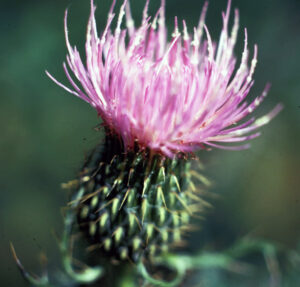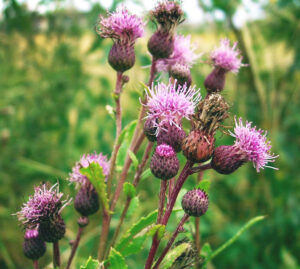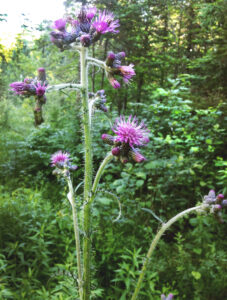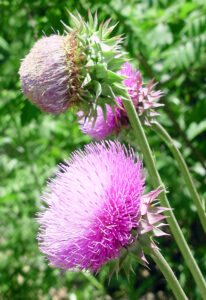By Erika Segerson-Mueller, DNR Invasive Plant Program Specialist, Oshkosh Service Center;
erika.segersonmueller@wisconsin.gov or 715-492-0391
With 10 thistle species present in Wisconsin, it can be tricky to determine which thistle is which. You may be tempted to control every thistle you see, assuming all types are invasive. But Wisconsin also has native thistles that provide valuable habitat and food for small birds and butterflies.
Thistles are either biennials (following a two-year life cycle) or perennials (regrowing every spring). They have lobed, spiny leaves and sometimes spiny stems. Thistles have composite flowers, with each flowerhead being composed of many tiny flowers, or florets.
Read on a for an overview of invasive thistles found in Wisconsin so you can stop wondering: Which thistle is this thistle?
Why are invasive thistles a problem?
Non-native thistles can be especially aggressive on disturbed sites, where changes to the land surface have happened through actions such as mowing, logging, or development, often leaving the area subject to accelerated erosion and establishment of invasive species.
Where non-native thistles are present, grazing animals avoid them and instead focus on native vegetation. This gives thistles a competitive advantage to spread and increases degradation of native grasslands and meadows.
Which thistles are invasive to Wisconsin?
Wisconsin has five invasive thistles that are similar in appearance to each other, as well as to native species. Four of these are currently regulated under Wisconsin’s Invasive Species Rule NR40. Except for Canada thistle, each type is a biennial and grows in a basal rosette the first year, sending up a flowering stalk in its second year.
1. Bull thistle (Cirsium vulgare)

Underneath the flowers of bull thistle are distinct bracts, modified leaves that have very spiny tips. / Photo Credit: Kenneth M. Gale, Bugwood.org
Bull thistle has sharp and very hairy leaves that are spiny on the upper surface with white, woolly hair on the undersides. Pink to purple flowers are 1.5 to 2 inches wide and have bracts (modified leaves surrounding the flower) with spiny tips.
Bull thistle is not regulated in Wisconsin but is an invasive species and can be controlled if preferred.
2. Canada thistle (Cirsium arvense)

Canada thistle has numerous smaller flowers with smooth bracts and stems; only the leaves of this thistle are spiny. / Photo Credit: Jan Samanek, Phytosanitary Administration, Bugwood.org
The only true perennial of the thistle species, Canada thistle has upright, grooved, hairy stems that can grow to more than 6 feet tall. It can be distinguished from other thistles by its creeping lateral roots that spread, creating solid dense stands of the plant.
The leaves of Canada thistle are spiny, but the stems and flower heads are not. Numerous purple to pink (and, rarely, white) flower heads are small (0.5-0.75 inches wide).
3. European marsh thistle (Cirsium palustre)

European marsh thistle usually has blooms in clusters of 12 or more. The flowers are spineless, but the stem leaves have spines on their tips. / Photo Credit: Caleb Slemmons, National Ecological Observatory Network, Bugwood.org
The flowers of European marsh thistle form clusters of 12 or more and are 0.75 inches wide. The bracts of the flowers have spineless tips and stem leaves are tipped with spines.
4. Musk thistle (Carduus nutans)

Musk thistle, also known as nodding thistle, has large solitary flowerheads that appear to bend or “nod” when mature. / Photo Credit: Ricky Layson, Ricky Layson Photography, Bugwood.org
Musk thistle has a multi-branched stem that appears winged. Second year flowering plants are 1 to 7 feet tall.
The flowers of musk thistle are large, measuring 1.5-3 inches across. They are red to purple and have solitary blooms at the end of stems. Another common name for this plant, nodding thistle, refers to the mature flowerheads that bend over and appear to “nod.”
5. Plumeless thistle (Carduus acanthoides)

The flowers of plumeless thistle are most like those of musk thistle but are smaller and grow both singly and in clusters. / Photo Credit: Todd Pfeiffer, Klamath County Weed Control, Bugwood.org
Plumeless thistle grows 3 to 6 feet tall in its second year, with branching stems. Both first- and second-year leaves are deeply divided with lobes ending in a spine.
Flowers are red-purple and grow both singly and in clusters, reaching up to one inch in diameter. Plumeless thistle is most similar in appearance to invasive musk thistle, though its solitary flowers are much smaller than those of musk thistle and its bracts have sharp spines.
What about native thistles?
Wisconsin has five native thistles that can be very similar in appearance to the invasive types. Pitcher’s thistle, Hill’s thistle, swamp thistle, field thistle and tall thistle can be found in varying habitats across the state.
Though not a definitive tactic, looking at the undersides of leaves can be a helpful identification tool. Native thistles generally have lower leaf surfaces (undersides) that are a pale white. The leaves of native thistle are also prickly, but not as aggressive or “dagger-like” as those of invasive thistles.
If you are on the brave side, another option is to “pet” a thistle plant upwards with your hand. A native thistle will not prick you as its barbs face upwards, but a run-in with an invasive type could prove rather painful.
How to control invasive thistles?
If you’ve identified thistles on your property as invasive types, control may be your next step. Removing first-year basal rosettes of leaves before flowers develop can be effective if you are confident the thistle is invasive. A general rule to help: invasive thistles often grow in dense populations or close together; native thistles are often dispersed throughout a landscape.
Repeated pulling and mowing of second-year plants is generally a good control method. It’s best to mow when flower buds are about to open, so plan for next year’s bloom in June and July.
Foliar pesticide treatment is also an option. For specific suggestions on chemical control of bull, European marsh, musk, and plumeless, check out the University of Wisconsin-Madison Extension publication on managing thistles.
For control information on the remaining invasive thistle, the University of Wisconsin-Madison Extension offers a specific publication for control of Canada thistle.
